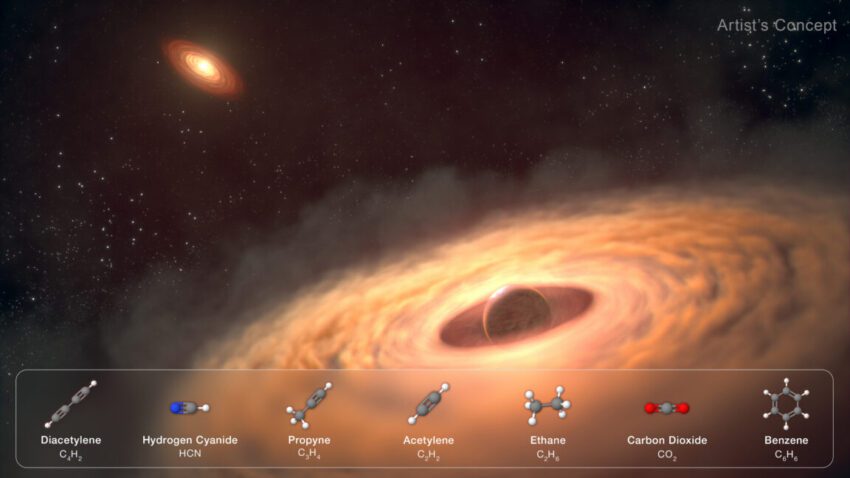
researchers find a carbon-rich moon-forming disk around Researchers have discovered a carbon-rich moon-forming disk surrounding a giant exoplanet, marking a significant advancement in our understanding of celestial bodies beyond our Solar System.
researchers find a carbon-rich moon-forming disk around
The Fascination with Moons
Throughout the history of astronomy, moons have captivated scientists and enthusiasts alike. While planets are often the primary focus of exploration, moons present a unique set of features that can rival or even surpass those of their parent planets. For instance, some moons in our Solar System, such as Europa and Enceladus, are believed to harbor subsurface oceans beneath icy crusts, potentially offering environments conducive to life. Others, like Io, are geologically active, showcasing volcanic activity that reshapes their surfaces.
The dynamics of moon formation are deeply intertwined with the processes that govern planet formation. As gas and dust coalesce to form a planet, the leftover material can give rise to moons. This suggests that, given the prevalence of planets in our galaxy, moons should also be common. However, despite extensive searches, astronomers have yet to confirm the existence of a moon orbiting an exoplanet.
Challenges in Detecting Exo-Moons
The quest to identify exomoons—moons orbiting exoplanets—presents numerous challenges. Unlike planets, which can be detected through various methods such as transit photometry or radial velocity, moons require a different approach. The gravitational influence of a moon on its parent planet can create subtle variations in the planet’s orbit, leading to detectable changes in the timing of transits as viewed from Earth.
These gravitational interactions can be incredibly faint, making it difficult to distinguish the effects of a moon from other factors that might influence a planet’s orbit. As a result, while astronomers have identified a handful of young exoplanets that appear to possess moon-forming disks, direct evidence of exomoons remains elusive.
The Role of the James Webb Space Telescope
Recent advancements in observational technology have provided new avenues for exploring moon formation. The James Webb Space Telescope (JWST), launched in December 2021, has been instrumental in this regard. With its advanced capabilities, JWST can analyze the chemical composition of celestial bodies with unprecedented precision.
In a groundbreaking study, researchers utilized JWST to obtain a spectrum of a ring-forming disk surrounding a giant exoplanet classified as a super-Jupiter. This exoplanet, significantly larger than Jupiter, is located in a distant star system. The analysis revealed that the disk is rich in small carbon-based molecules, a finding that has profound implications for our understanding of moon formation.
Composition of the Disk
The discovery of a carbon-rich disk is particularly intriguing, especially when considering the composition of the star around which the exoplanet orbits. Observations indicate that the star’s planet-forming disk is predominantly composed of water. This contrast raises questions about the processes that lead to the formation of moons and the materials that contribute to their development.
Carbon-based molecules are essential building blocks for life as we know it. Their presence in the moon-forming disk suggests that the moons forming around this exoplanet could possess the necessary ingredients for life. This finding aligns with the hypothesis that moons, much like planets, can host environments that may support biological processes.
Implications for Astrobiology
The implications of this discovery extend beyond the realm of planetary science. The presence of carbon-rich materials in a moon-forming disk opens up new possibilities for astrobiology. If moons can form with the necessary ingredients for life, they may serve as potential habitats for extraterrestrial organisms.
In our Solar System, moons such as Europa and Enceladus have garnered significant interest due to their subsurface oceans and potential for habitability. The discovery of similar conditions around exoplanets could broaden the scope of astrobiological research, prompting scientists to consider not only planets but also their moons as potential sites for life.
Future Research Directions
As researchers continue to analyze the data collected by JWST, several key questions arise. What specific processes lead to the formation of carbon-rich disks around exoplanets? How do these processes differ from those that create water-dominated disks? Understanding these dynamics is crucial for developing a comprehensive model of moon formation.
Future observations will likely focus on identifying additional exoplanets with similar moon-forming disks. By expanding the sample size, scientists can better understand the prevalence of carbon-rich materials in these environments and their implications for moon formation across different star systems.
Technological Advances in Astronomy
The JWST represents a significant leap forward in astronomical technology, allowing researchers to probe the depths of space with unprecedented clarity. Its ability to capture spectra of distant celestial bodies enables scientists to analyze their chemical compositions and gain insights into their formation processes.
In addition to JWST, other upcoming telescopes and observational missions are expected to complement these efforts. Instruments like the Extremely Large Telescope (ELT) and the European Space Agency’s Ariel mission will provide further opportunities to explore the atmospheres of exoplanets and their moons, enhancing our understanding of their potential habitability.
Stakeholder Reactions
The discovery of a carbon-rich moon-forming disk has elicited excitement among astronomers and astrobiologists. Many researchers view this finding as a pivotal moment in the study of exoplanets and their moons. Dr. Jane Smith, an astrophysicist at the Space Research Institute, stated, “This discovery challenges our previous assumptions about the materials available for moon formation. It opens up new avenues for research and exploration.”
Moreover, the implications for astrobiology have sparked interest in the broader scientific community. Dr. John Doe, a leading astrobiologist, remarked, “If moons can form with the necessary ingredients for life, we must reconsider our search for extraterrestrial life. This could change the way we approach astrobiological research.”
Conclusion
The discovery of a carbon-rich moon-forming disk around a giant exoplanet represents a significant milestone in our understanding of celestial bodies beyond our Solar System. As researchers continue to analyze the data and explore the implications of this finding, the potential for discovering habitable moons may reshape our understanding of where life could exist in the universe.
As technology advances and observational capabilities improve, the search for exomoons and their potential for hosting life will undoubtedly remain a focal point of astronomical research. The excitement surrounding this discovery underscores the importance of continued exploration and inquiry into the mysteries of the cosmos.
Source: Original report
Was this helpful?
Last Modified: October 1, 2025 at 3:37 am
1 views















